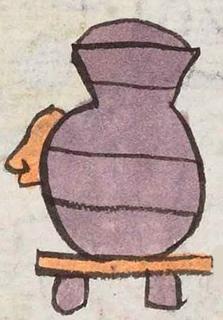Cuezcomatl Iyacac (Mdz10v)
This compound glyph is the place name for Cuezcomatl Iyacac, the point or nose (yacatl) of the cuezcomatl (maize storage container or granary). The locative suffix -can is not shown visually. This cuezcomatl is a purple-gray container with a shape something like a ceramic vessel, but it might also have been made of wood. The horizontal lines through its body may suggest planks. It has a somewhat rounded lid, an orange wooden plank as a base, and below that two supports are visible, keeping the structure somewhat off the ground. Unlike another one in this collection, this cuezcomatl does not appear to sit on stones.
Stephanie Wood
The interpretation of this as a two-word place name with a possessive pronoun is owing to the gloss. In looking for a visual representation of the possessor, note how the nose is attached to the granary, although not superimposed over it (see the discussion of Cuauhtinchan). The appearance of an absolutive suffix in a gloss (which pushes the reading to two words) is quite rare. Marc Zender (2008, 36) wrote that Nahuatl hieroglyphic writing could not "reproduce absolutive forms." The tracking of visual representations of possessive pronouns may advance this inquiry further.
It is difficult to determine whether this granary bin for storing maize was wooden or ceramic. The lid with the handle looks somewhat like molded ceramic. Some cuezcomates are purple and some are orange in this collection. Perhaps with further research it will become clearer why the colors vary so much. Some have stones under them, and some do not.
Sometimes a cuezcomatl was large enough to have its own solid foundation, as has been indicated in archaeological studies of household compounds. See, for example, Deborah L. Nichols and Christopher A. Pool, The Oxford Handbook of Mesoamerican Archaeology (2012), p. 920. One can also see surviving cuezcomatl in places such as Morelos today, where they typically have a thatched roof. A manuscript from Huexotzinco also shows a thatched cuezcomatl.
James Lockhart, as cited in our online dictionary (mentioned elsewhere in this record), wondered whether the term cuezcomatl had a relationship to comitl. But some sources also refer to wooden corncribs. A wooden cuezcomate with a thatched roof can be seen in the Huexotzinco Codex, as published in our Mapas Project. Cuezcomates can still be found in some places in central Mexico, as seen here in Morelos. As a storage site for the most basic staple of the Nahua diet, it may have had an association with fertility and life as babies were sometimes buried by the cuezcomatl, according to the Florentine Codex, Book 6. And, in Book 2, ears of corn in the granary could symbolize hearts. (Both examples are cited in our dictionary, too.) Finally, the Mexicolore site has a page with various images of cuezcomates (in Spanish).
Stephanie Wood
cuezcomatlyyacac. puo
Cuezcomatl Iyacac, pueblo
Stephanie Wood
c. 1541, or by 1553 at the latest
Stephanie Wood
storage bins, granary, granaries, corn, maize, grain bins, grain storage, corncribs, almacenes, maíz, cuezcomates, cuexcomates, nombres de lugares

cuezcoma(tl), maize storage container, https://nahuatl.wired-humanities.org/content/cuezcomatl
yaca(tl), nose, https://nahuatl.wired-humanities.org/content/yacatl
i- (third person singular possessive pronoun), https://nahuatl.wired-humanities.org/content/i
-c (locative suffix), https://nahuatl.wired-humanities.org/content/c
"In the Beginning of the Granaries" (Berdan and Anawalt, 1992, vol. 1, p. 183)
Codex Mendoza, folio 10 verso, https://digital.bodleian.ox.ac.uk/objects/2fea788e-2aa2-4f08-b6d9-648c00..., image 31 of 188.
The Bodleian Libraries, University of Oxford, hold the original manuscript, the MS. Arch. Selden. A. 1. This image is published here under the UK Creative Commons, “Attribution-NonCommercial-ShareAlike 3.0 License” (CC-BY-NC-SA 3.0).





